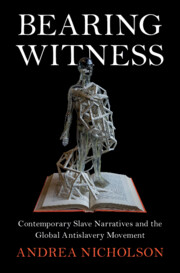Book contents
- Bearing Witness
- Slaveries since Emancipation
- Bearing Witness
- Copyright page
- Epigraph
- Contents
- Figures
- Preface
- Acknowledgments
- Introduction
- 1 A Narrated Self
- 2 “I Was Free, I Still Wasn’t Free”
- 3 The Construction and Reconstruction of Survivor Identities
- 4 Bearing Witness
- 5 Assuming “Full” Freedom
- 6 Antislavery Strategies and the Survivor as Activist
- Conclusion
- Appendix: Table of Narratives analyzed
- Bibliography
- Index
2 - “I Was Free, I Still Wasn’t Free”
Defining Freedom
Published online by Cambridge University Press: 22 September 2022
- Bearing Witness
- Slaveries since Emancipation
- Bearing Witness
- Copyright page
- Epigraph
- Contents
- Figures
- Preface
- Acknowledgments
- Introduction
- 1 A Narrated Self
- 2 “I Was Free, I Still Wasn’t Free”
- 3 The Construction and Reconstruction of Survivor Identities
- 4 Bearing Witness
- 5 Assuming “Full” Freedom
- 6 Antislavery Strategies and the Survivor as Activist
- Conclusion
- Appendix: Table of Narratives analyzed
- Bibliography
- Index
Summary
Chapter 2 begins thematically with survivors’ perceptions of freedom, exploring how survivors perceive slavery as a physical reality and freedom as a relative concept, drawing out themes of resistance, death, and education as freedom. It is argued that the simple binary conception of “free” and “not free” is an artificial one. Contrary to the belief that slavery is a constant, and that freedom is both an immediate and joyful escape from enslavement, micro freedoms occur and are assumed during slavery. Conversely, slavery continues in the mind of the free, leaving individuals in a permanent state of survival and undermining the realisation of meaningful, and what Frederick Douglass called “full,” freedom.
- Type
- Chapter
- Information
- Bearing WitnessContemporary Slave Narratives and the Global Antislavery Movement, pp. 48 - 70Publisher: Cambridge University PressPrint publication year: 2022

